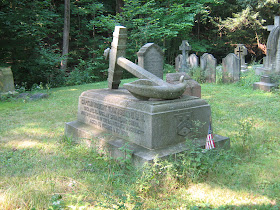This massive square granite headstone in an old section of the South Ridge (not too far from the lovely grave of Daniel Campbell) marks the grave of Senator Ira Harris, a man whose family history is closely linked to the Lincoln assassination.
Harris was born in 1802 on a farm near Charleston, Montgomery County. Educated at Union College, he was admitted to the bar in 1828 and practiced law in Albany. His active political and civic career included tenures the New York State Assembly, the New York State Constitutional Convention (1846), New York State Senate, and New York State Supreme Court. He also served as president of Union College and was a founder of Albany Law School.
In 1861, he was elected to the United States Senate to replace William H. Seward after the latter was appointed Secretary of State by President Abraham Lincoln. Senator Harris would become a friend of the President and a regular visitor to the Lincoln White House (which led to a joke that Lincoln would check under his bed each night to make sure Senator Harris was not there with yet another patronage request).
On the night that Lincoln was assassinated at Ford's Theatre, his guests for the evening were Senator Harris' daughter, Clara, and her fiance, Colonel Henry Rathbone (who was also Senator Harris' stepson). Rathbone was wounded by Booth's knife during the assassination and his failure to prevent the President's death would haunt Henry for the rest of his life. In 1883, suffering from declining mental health, Henry stabbed Clara to death and attempted to take his own life (he survived, was declared insane, and died in an asylum in 1911).
Senator Ira Harris' summer home just off modern-day Route 9 in Loudonville still stands. Located just minutes from the South Gate of the Albany Rural Cemetery, the old Loudon Cottage (which is privately owned) is said to be haunted by Lincoln. Clara's evening gown, stained with Lincoln's blood, was reportedly sealed in a closet there and the slain President's ghost has been seen there by a number of people, beginning with Clara who is said to have seen the apparition on the first anniversary of the assassination.
Senator Ira Harris died on December 2, 1873 after an illness described in contemporary accounts as "paralysis." He was buried in his family's lot at the Rural Cemetery. The back of the monument lists other member of the Harris family interred there.
Ira Harris was also a part of the Rural Cemetery's history; he was a founding member of the Albany Cemetery Association and served as a Trustee of the Cemetery from its incorporation until his death. It was Harris who, after receiving a letter from the General's granddaughter, presented the resolution to have Phillip Schuyler's remains transferred from an obscure grave in the Van Rensselaer family lot to a new lot marked with a fine column more in keeping with Schuyler's legacy as a key figure in the region's Revolutionary-era history.
Thursday, September 27, 2012
Sunday, September 16, 2012
Squire Whipple
This modest headstone of black granite on the South Ridge near the graves of Herman Melville's parents and the brownstone sarcophagus of Cortlandt Van Rensselaer marks the grave of Squire Whipple, a civil engineer known as "the father of iron bridge building"
Born in Massachusetts and educated at Union College in nearby Schenectady, Whipple is best remembered locally for the bowstring truss bridge preserved in the Normanskill Hollow between Albany and Delmar.
Squire Whipple on Wikipedia
Born in Massachusetts and educated at Union College in nearby Schenectady, Whipple is best remembered locally for the bowstring truss bridge preserved in the Normanskill Hollow between Albany and Delmar.
Squire Whipple on Wikipedia
Monday, September 10, 2012
Captain Townsend's Anchor
The Townsend family plot is a large fenced lot alongside the Moordanaers Kill on a low path between the Cemetery's Middle and South Ridges. Located just across from the De Peyster Douw hillside crypt, it contains a number of noteworthy graves, but the most distinctive monument here is undoubtedly the massive granite anchor marking the resting place of Captain Robert Townsend.
A member of a prominent Albany family which included mayors, generals, and businessmen, Captain Townsend served in the U.S. Navy during the Mexican War (commanding the Porpoise) and the Civil War (commanding the Miami and Essex). At the age of forty-six, he died of heatstroke in China while in command of the Wachusett
A set of historic artifacts which once belonged to Captain Robert Townsend was recently the subject of a Times Union article.
The photo below shows Townsend lot as it appeared in the late 1800s. An early history of the Cemetery describes the anchor tomb as "at once elegant, modest, and substantial."
Anchors appears on a number of other monuments in the Cemetery (such as the John Bogart marble), either as a symbol of steadfast faith or an emblem of a maritime career.
(An iron cover made by the Townsend Furnace can still be seen near the Capitol. Click here for a photo.)



